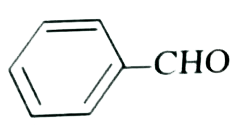Compound 'A' with molecular formula C4H9Br is treated with aq. KOH solution. The rate of this reaction depends upon the concentration of the compound 'A' only. When another optically active isomer 'B' of this compound was treated with aq. KOH solution, the rate of reaction was found to be dependent on concentration of compound and KOH both.
(i) Write down the structural formula of both compounds 'A' and 'B'.
(ii) Out of these two compounds, which one will be converted to the product with inverted configuration. Solution in Gujrati
(i) The reaction procceeds through SNI path as the given substrate is 3∘ - alkyl halide.
CH3−CH3| C | Br −CH32-Bromo-2-methylpropaneKOH(aq)−−−−−→CH3−CH3| C | OH−CH32-Methylpropan-2-ol
(ii) Compound (B) forms a product of inverted configuration as it undergoes SN2 reaction.

Topper's Solved these Questions
- BOOK - KUMAR PRAKASHANCHAPTER - HALOALKANES AND HALOARENESEXERCISE - SECTION - D NCERT EXEMPLAR SOLUTION (Matching The Columns)6videos
HALOALKANES AND HALOARENES
- BOOK - KUMAR PRAKASHANCHAPTER - HALOALKANES AND HALOARENESEXERCISE - SECTION - D NCERT EXEMPLAR SOLUTION (Assertion and Reason Type)10videos
HALOALKANES AND HALOARENES
- BOOK - KUMAR PRAKASHANCHAPTER - HALOALKANES AND HALOARENESEXERCISE - SECTION - D NCERT EXEMPLAR SOLUTION (Multiple Choice Questions)43videos
HALOALKANES AND HALOARENES
- BOOK - KUMAR PRAKASHANCHAPTER - GENERAL PRINCIPLES AND PROCESSES OF ISOLATION OF ELEMENTSEXERCISE - SECTION - E (MCQs ASKED IN GUJET/BOARD EXAMS)46videos
GENERAL PRINCIPLES AND PROCESSES OF ISOLATION OF ELEMENTS
- BOOK - KUMAR PRAKASHANCHAPTER - POLYMERSEXERCISE - SECTION - E (MCQs asked in Board Exams)51videos
POLYMERS
Similar Questions
Match the compounds given in Column - I with the effects given in Column - II.
Column - IColumn - II(i)Chloramphenicol(a)Malaria(ii)Thyroxine(b)Anaesthetic(iii)Chloroquine(c)Typhoid fever(iv)Chloroform(d)Goiter(e)Blood substituent01:31View SolutionAssertion (A) : Phosphorus chlorides (tri and penta) are preferred over thionyl chloride for the preparation of alkyl chlorides from alcohols.
Reason (R ) : Phosphorus chlorides give pure alkyl halides.03:56View SolutionThe order of reactivity of following alcohols with halogen acids is ………
(A) CH3CH2−CH2−OH
(B) CH3CH2−C | CH3H−OH
(C ) CH3CH2−CH3| C | CH3−OH08:14View SolutionDuring electrolysis of aqueous solution of Na2SO4 using graphite electrode .........
View SolutionWhich polymer is used in preparation of capsules ?
View SolutionWhich product is formed when the compound is treated with concentrated aqueous KOH solution ?
08:14View SolutionWhich product is formed when the compound
 is treated with concentrated aqueous KOH solution?07:32View Solution
is treated with concentrated aqueous KOH solution?07:32View SolutionCompound 'A' with molecular formula C_(4)H_(9) Br is treated with aq. KOH solution. The rate of this reaction depends upon the the concentration of the compounds 'A' only. When another optically active isomer 'B' of this compound was treated with aq. KOH solution, the rate of reaction was found to be dependent on concentration of compound and KOH both. (i) Write down the structural formula of both compounds 'A' and 'B'. (ii) Out of these two compounds, which one will be converted to the product with inverted configuration.
View SolutionWhich product is formed when the compound is treated with concentrated aqueous KOH solution
03:55View SolutionCompounds A and B are the structural isomers of each other with molecular formula C_(4)H_(9)Br . Compound 'A' is a linear chain and optically inactive while 'B' is optically active. When compound 'A' is treated with aq. KOH solution, it gives compound 'C' whereas compound 'B' when treated with aq.KOH solution, it gives compound 'D'. Identify compound 'C' and 'D'.
04:35View SolutionCompound 'A' with molecular formula C_(4)H_(9)Br is treated with aq. KOH solution. The rate of this reaction depends upon the concentration of the compound 'A' only. When another optically active isomer 'B' of this compound was treated with aq. KOH solution, the rate of reaction was found to be dependent on concentration of compound and KOH both. (i) Write down the structural formula of both compounds 'A' and 'B'. (ii) Out of these two compounds, which one will be converted to the product with inverted configuration.
06:35View SolutionCompound 'A' with molecular formula C4H9Br is treated with aq.KOH solution. The rate of this reaction depends upon the concentration of the compound 'A' only. When another optically active isomer 'B' of this compound was treated with aq. KOH solution, the rate of reaction was found to be dependent on concentration of compound and KOH both.
(i) Write down the structural formula of both compounds 'A' and 'B'.
(ii) Out of these two compounds, which one will be converted to the product with inverted configuration.02:49View SolutionCompound 'A' with molecular formula C4H9Br is treated with aq. KOH solution. The rate of this reaction depends upon the concentration of the compound 'A' only. When another optically active isomer 'B' of this compound was treated with aq. KOH solution, the rate of reaction was found to be dependent on concentration of compound and KOH both.
(i) Write down the structural formula of both compounds 'A' and 'B'.
(ii) Out of these two compounds, which one will be converted to the product with inverted configuration.04:35View SolutionWhich product is formed when the compound is treated with concentrated aqueous KOH solution ?
02:49View SolutionCompound 'A' with molecular formula C_(4)H_(9) Br is treated with aq. KOH solution. The rate of this reaction depends upon the the concentration of the compounds 'A' only. When another optically active isomer 'B' of this compound was treated with aq. KOH solution, the rate of reaction was found to be dependent on concentration of compound and KOH both. (i) Write down the structural formula of both compounds 'A' and 'B'. (ii) Out of these two compounds, which one will be converted to the product with inverted configuration.
02:49View Solution

